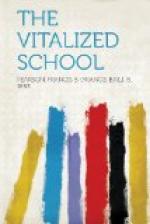=Etymology.=—Etymology has its place, of course, in the study of words, but it stops short of the goal. It may be well to take the watch apart in order to make an examination of its parts, but until it is reconstituted and set going, it is useless as a watch. So with a word. We may give its etymology and rhapsodize over its parts, but thus analyzed it is an inert thing and really inane so far as real service is concerned. If word study does not carry beyond the mere analysis, it is futile as a real educative process. To be really effective, the word must be instinct with life and busy in the affairs of life, and not a mere specimen in a museum. Too often our work in etymology seems to be considered an end in itself, rather than a means to an end.
=The word in use.=—Arlo Bates says that the word “highly” in the Gettysburg Speech is the most ornate word in the language in the setting that Lincoln gave it. The merest tyro can give its etymology, but only when it was set to work by a master did it gain potency and distinction. The etymology of the word “fidelity” is reasonably easy, but this analysis is powerless to cause the child to thrill at the story of Casabianca, or of Ruth and Naomi, or of Esther, or Antigone, or Cordelia, or Nathan Hale, or the little Japanese girl who deliberately bit through her tongue that she might not utter a syllable that would jeopardize the interests or safety of her father. The word analyzed is a dead thing; the word in use is a living thing. The word merely analyzed is apt to be ephemeral; the word in use is abiding and increasingly significant. As the child puts more and more content into the word, he, himself, expands at the same rate in the scope and power of his thinking. Words are the materials out of which he weaves the fabric of life, and the pattern depends upon the content of his words.
=Illustrations from art.=—The child can spell the word “art” and can repeat the words of the book by way of a memorized definition, but he cannot define the word with even a fair degree of intelligence. He cannot know the meaning of the word until its significance becomes objectified in his life processes. This requires time, and thought, and experiences with books, with people, and with galleries. In short, he must live art before he can define the word; and his living art invests the word with content. The word will grow just as he grows in his conception of art. At first, he may denominate as art the simple little daubs of pictures that he makes with the teacher’s hand guiding his brush. But, later on, as he gains a larger conception, these things will appear puerile if not silly. The time may come when he can read the thoughts of the masters as expressed in their masterpieces. Then, and only then, will he be able to define the word.




